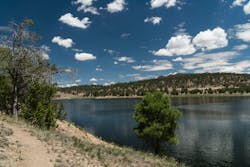Leveraging Customer Engagement & Analytics for Water Conservation
More water utility providers are utilizing customer data to boost water conservation efforts and reduce usage in the communities they serve.
As unprecedented water shortages and droughts sweep across the US, water utilities must help customers conserve resources, reduce usage and lower total consumption. How can the right data boost customer compliance with watering schedules and conservation? Analytics gathered using advanced metering infrastructure (AMI) can help.
By combining deep analytics, targeted engagement and robust automation, utilities can fully leverage their AMI data and tech investments to improve customer awareness, especially through irrigation and leak detection.
The Power of Irrigation and Leak Detection
Irrigation detection allows utilities to monitor regular customer consumption, such as the use of an automated irrigation controller. Helping customers understand this data creates a strong connection between their daily usage and the bill they receive digitally or through the mail each month.
Irrigation detection helps utilities encourage or enforce compliance with watering schedules or usage limitations, especially during droughts or shortages. It also distinguishes irrigation from continuous use, such as leaks or normal consumption within a home. This saves time for utility employees by eliminating or reducing the need for truck rolls or in-person visits to ensure customers are not watering at the wrong times.
This feature takes the guesswork out of usage. Customers and utilities understand when and where water is consumed, leading to water savings.
A leak detection system offers closed-loop leak resolution. It automatically identifies and alerts customers of continuous water use at their property and empowers them to find and fix the leak on their own, leading to a reduction in wasted resources and high bills.
With the right data, utilities can pinpoint leaks, helping customers understand where they may be losing water. With the power of automation and omnichannel engagement, utilities can go even further to catch leaks right after they happen, resulting in water conservation.
Water Conservation & Restrictions
More than 97% of California is experiencing severe, extreme or exceptional droughts, and those living in southern parts of the state are being asked to reduce water usage by up to 35%. These conditions may call for even greater restrictions placed on water consumption in certain areas, exacerbating the need for conservation awareness.
As states like Texas, New Mexico and Colorado face similar challenges, water usage restrictions may become more commonplace. Leak and irrigation detection can help utilities implement and increase the effectiveness of their drought contingency plans to comply with state, local and federal water codes.
For example, Central Texas regulators (e.g., groundwater districts) are beginning to introduce increased drought restrictions, causing their water utility permit holders to institute associated restrictions in their communities. Using AMI-based irrigation detection, utilities not only avoid the added burden of enforcing outdoor watering restrictions, but also achieve measurable increases in customer compliance and water savings.
Now, water utility professionals can detect timed irrigation, monitor compliance with watering schedules, send a targeted group message to non-compliant irrigators and measure the outcome — all in a few clicks.
Communication & Water Conservation
A recent study of 322 U.S. utilities found that AMI can encourage customers to reduce water consumption depending on customer engagement, portal features, communication methods, customer characteristics and other factors. Although AMI portals greatly benefit customers and their utilities, it is also crucial to consider the larger picture.
Portal sign-ups do not tell the entire story. Regardless of portal registration, utilities can engage customers in other ways, such as through text and email messages. By leveraging an omnichannel engagement approach (e.g., email, text, voice, print and portal), utilities can reach customers in the channel of their choice and thus drive portal adoption. This is especially important as utilities are expected to deliver critical communications regarding extreme weather events, the COVID-19 pandemic, boil water notices and other service-related matters.
That is why water utilities should refrain from restricting the benefits of technology and customer engagement to portal users. Communicating with customers through their preferred channels about issues that matter to them makes them more likely to register for the portal — a win-win situation for all.
How Can Utilities Promote Water Conservation to Different Meter Classes?
Different customers have different needs. Business needs differ from the needs of residences, and small businesses operate differently than large industries.
Gathering the right data and analytics allows utilities to segment their customers by meter class. Although this may include information gathered through AMI, it is important to consider other data sources. The ability to access analytics for every meter class gives utilities insights into consumption rates and trends that can be used to engage certain customer types more effectively. That means utilities can send targeted, personalized messages that pair insights with actionable recommendations to all customers.
How Can You Win the Conservation Battle?
A comprehensive analytics and engagement platform can help utilities win the water conservation challenge, especially as water shortages and droughts plague the U.S. Today’s utilities have the unique opportunity to effectively educate their communities about water conservation and environmentally friendly behaviors to secure a more resource-rich future.
About the Author
Michelle Camp
Senior Sales Director
Michelle Camp has been forging partnerships with utilities across the U.S. since 2015. Before joining VertexOne, Michelle played a key role in growing the business at WaterSmart Software for nearly five years. Michelle graduated from The University of Texas at Austin with a B.S. in Environmental Science. Michelle also holds a Master of Environmental Management from Yale University with a specialization in water resource science and management.
